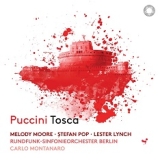Warum weint Cavaradossi schon in seiner Arie Recondita Armonia? Eigentlich hat Tenor Stefan Pop das nicht nötig, denn im weiteren Verlauf der Oper zeigt er sich meistens (aber nicht immer) in guter Form und singt auch so, wie man es von einem Interpreten des Cavaradossi erwartet.
Doch dies ist bloß eine von vielen Fragen, die sich mir beim Anhören dieser neuen Tosca-Einspielung stelle. Warum bringt Carlo Montanaro es nicht fertig, die für Puccini unabdingbare melodische Linie zu halten und schafft immer wieder Löcher im musikalischen Fluss? Warum klingt die Tosca von Melody Moore so eng-säuerlich, gequetscht und meistens kühl, wo ist ihre Leidenschaft? Und überhaupt, wo ist die Spannung, die die Begegnung Tosca-Cavaradossi im ersten Akt auszeichnen müsste, wo Elektrizität in der Luft liegen sollte und es hier kaum zum lauen Lüftchen kommt? Man hat ständig den Eindruck, Montanaro helfen zu müssen, seinen Karren voranzutreiben, der bei ihm immer im Schlamm stecken bleibt.
Die Szene Tosca-Scarpia bleibt spannungsarm, und die Musik vor dem Te Deum, die eigentlich jeden erschauern lassen sollte, glitscht bedeutungslos am Hörer vorbei, genau wie die Folterszene im 2. Akt.
Melody Moores Vissi d’arte ist drittklassig, auch wenn der Rest des 3. Aktes irgendwie passabel geraten ist. In seiner Arie Lucevan le stelle weint Pop dann wieder, was seinem an sich guten Gesang mehr schadet als nützt. Und Moore ist auch in der Schlussszene keine Tosca, keine Diva, es fehlt ihr einfach an Persönlichkeit.
Fazit: Angesichts der Zahl herausragender Aufnahmen der Puccini-Oper ist diese mehr als überflüssig.
Why does Cavaradossi cry already in his aria Recondita Armonia? Actually, tenor Stefan Pop has no need for that, because in the further course of the opera he mostly (but not always) shows himself in good form and also sings as one would expect from an interpreter of Cavaradossi.
But this is merely one of many questions that arise in my mind when listening to this new Tosca recording. Why does Carlo Montanaro not manage to keep the melodic line that is indispensable for Puccini and keeps creating holes in the musical flow? Why does Melody Moore’s Tosca sound so tightly sour, squashed and mostly cool, where is its passion? And in general, where is the tension that should characterize the Tosca-Cavaradossi encounter in the first act, where electricity should be in the air and there is hardly a breeze here? One constantly has the impression of having to help Montanaro push his cart, which always gets stuck in the mud.
The Tosca-Scarpia scene remains tensionless, and the music before the Te Deum, which should actually make everyone shiver, slips past the listener meaninglessly, just like the torture scene in Act 2.
Melody Moore’s Vissi d’arte is third-rate, even if the rest of Act 3 is somehow passable. Then in his aria Lucevan le stelle, Pop cries again, which does more harm than good to his singing, which is good in itself. And Moore is no Tosca, no diva, even in the final scene; she simply lacks personality.
Conclusion: Given the number of outstanding recordings of Puccini’s opera, this one is more than superfluous.
























